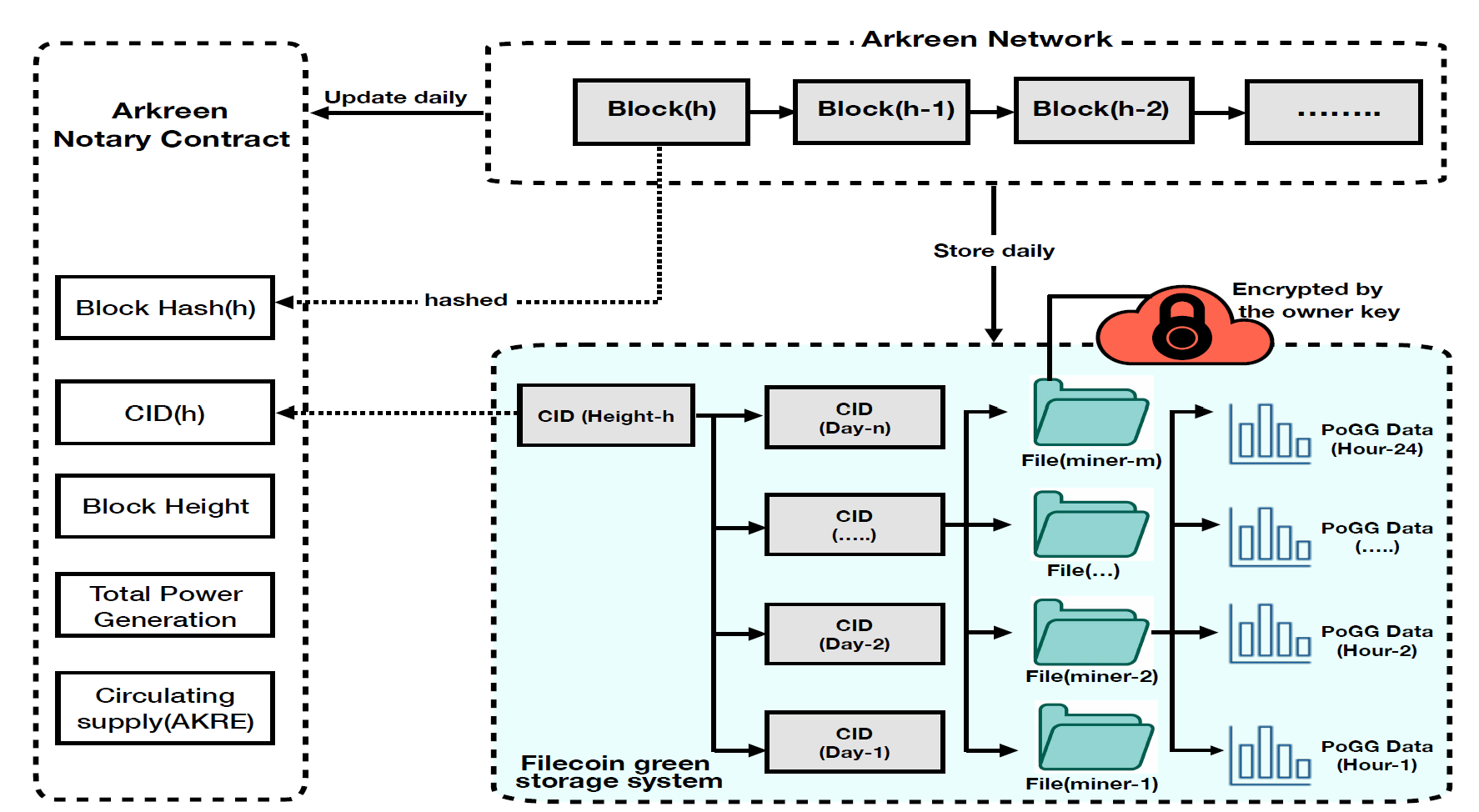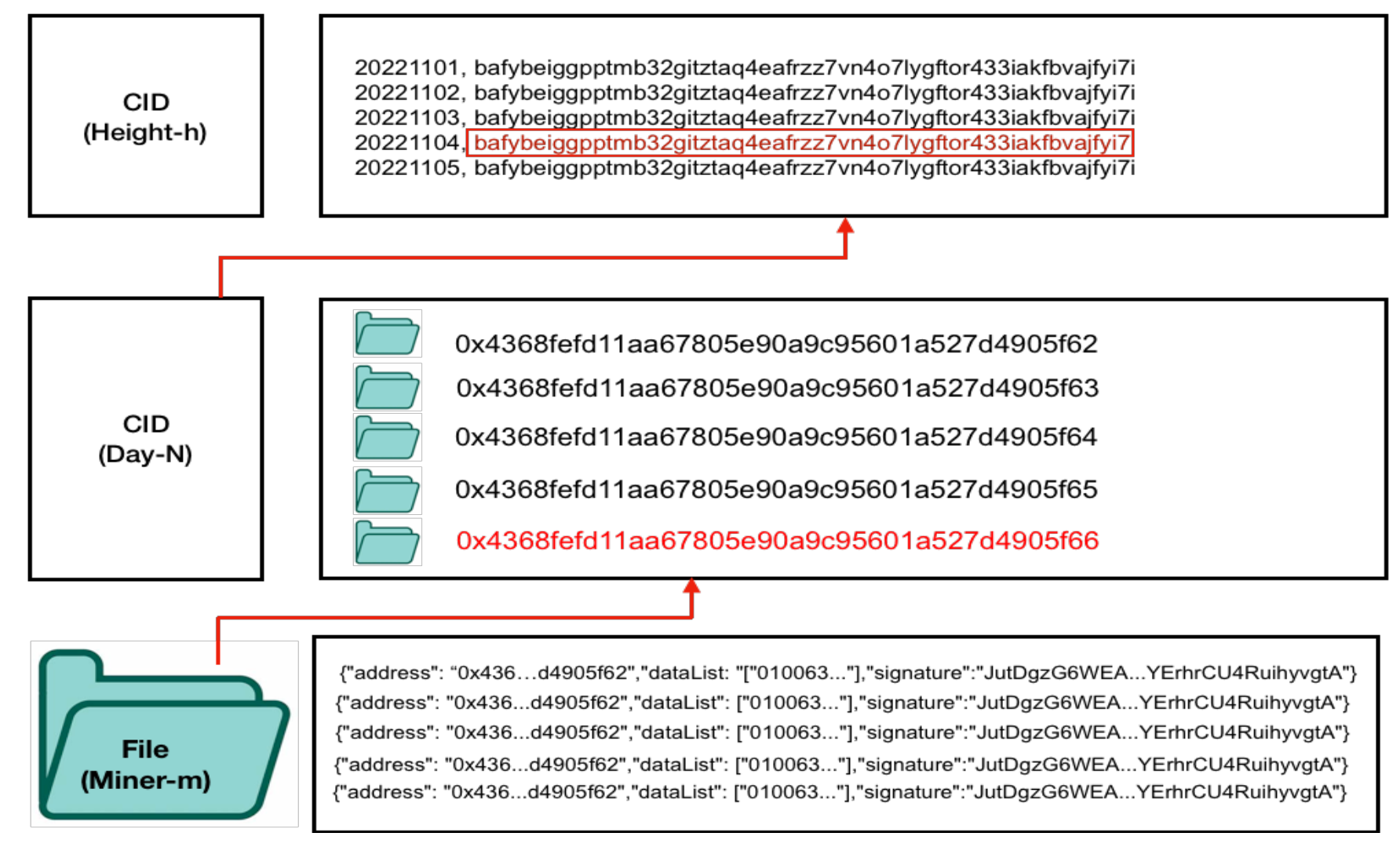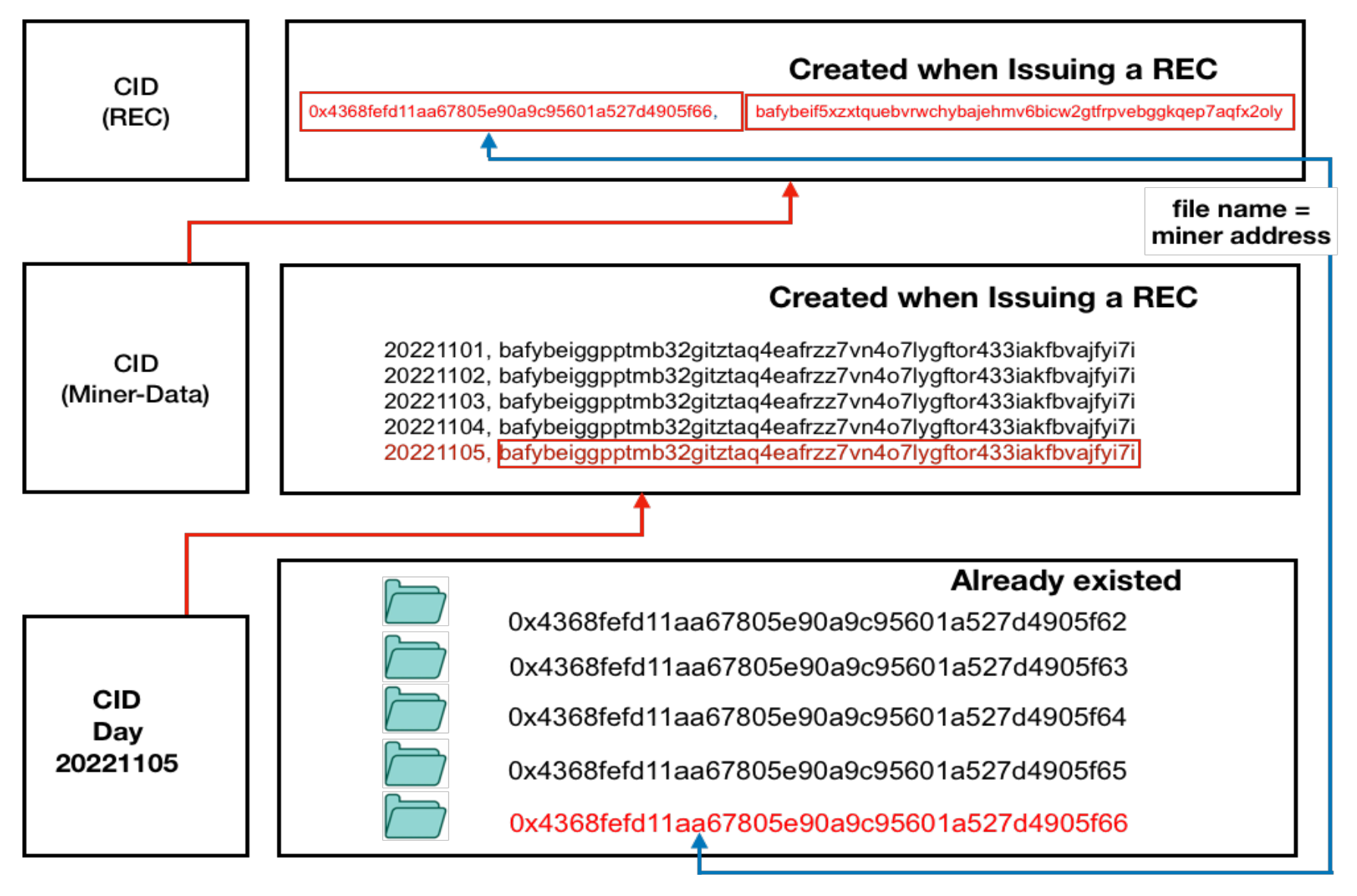Electricity-generation data Storage in Filecoin
Many decentralized global infrastructure platforms, such as Arkreen Network, that combine crypto-economic incentives, blockchain, and the Internet of Things (IoT), convergent solutions together have a singular opportunity to promote collective action toward mitigating carbon emissions, demonstrate industry-wide decarbonization, and stimulate new demand for clean energy resources. Arkreen is a web-3 decentralized global resource energy distribution platform built on the Polygon blockchain network and powered by Filecoin green storage to enable the interconnection and monetization of distributed energy resources for carbon reduction applications.
This article aims to describe the key components of the Arkreen Network from the perspective of how the green (solar) electricity energy data as well as the REC (Renewable Energy Certificate) data is stored in Filecoin green storage
The article contains four parts:
a) The Arkreen Network architecture;
b) The green generation data storage in the filecoin storage system;
c) The REC data storage in Filecoin;
d) Estimation of the data storage size.
Arkreen Network allows miners to report the green data to the Arkreen Network based on the PoGG protocol. The Arkreen Network collects and stores the green data in the Filecoin green storage system, and allows the miner or user to apply the data toward the creation of RECs ( Renewable Energy Credits), which will be monetized on the Arkreen network. The Notary architecture diagram of the Arkreen Network is illustrated in the chart below:

Figure 1: Notary architecture of the Arkreen Network
How the Arkreen network uploads and retrieves data, by utilizing the Filecoin green storage system
The Arkreen Network tracks its production of green energy by drawing from our cutting-edge algorithm known as Proof of Green Energy Generation (PoGG). All miners who complete the PoGG tasks will receive an incentive. The PoGG assists the Arkreen Network in measuring its green energy generation which is the foundation for the network's ability to offer services associated with green energy data assets. The Arkreen network pays miners who continuously submit accurate data about the production of green electricity. All Arkreen Network-connected miners are required to sample data at intervals of every five minutes (5 mins), store it locally, and submit the cached data every hour (1 hr). The miner can then erase the local cache data and get ready for the subsequent data report after reporting this data.
Below describe the major components of the Arkreen Network that store green data in the filecoin green storage format.
Content identifiers (CID) are created daily.
Arkreen Network, like any other platforms that use filecoin storage, uses CIDs that are created when the data is uploaded into the filecoin green storage. A CID is a self-describing, content-addressed identifier. Cryptographic hashes are used to locate the content. To enable flexible self-description, it makes use of several multiformats, including multihash** for hashes, _multicodec for different data content types, and multibase_ ** to encode the CID into strings. See https://docs.cid.contact/filecoin-network-indexer/overview.
After the miner reports a sufficient amount of green data, the Arkreen Network uploads the miner’s data to the Filecoin green storage system based on the PoGG. The data is not stored in real-time, it can be uploaded after every 1-2 days (24–48 hours). Based on the standard time setting in the network, notably every 1:00 AM, the Arkreen Network collects and uploads the green data generated for the previous day for all miners that provided the green data in the Arkreen Network and uploaded it to the filecoin green storage system.
Below describe the parameters in the CIDs.
1. CID height-h: contains all the data and the time that can be uploaded to the network.
2. CID Day-N: number of days created a CID for the miner file that the Arkreen Network created.
3. File Miners-m: which can be remote or standard miners are files that contain green data supply in the Arkreen Network and this data file can be uploaded in the filecoin green storage system. The miners have many files in the form of transactions that are recorded in the Filecoin green storage system; each miner has an address, a signature, and transactions in the file.\

Figure 2: Daily CID construction on the Arkreen Network
Every day, the Arkreen Network will create a CID that is related to the block height (BlockHeight-h) together with a time stamp. The CID file contains a single file, and its content is the index of every day. For example, the first CID is created to store entire mine data for a miner or user. Every file in filecoin green has a CID, which is created daily. New CID Day-N has many files, and each contains miner-recorded data. The process for collecting the data from the Arkreen database is at random after a query from the Arkreen Network and storing it in the Filecoin green storage system.
How the miner or user retrieves green data and creates ERC20 RECs for monetization
Users can select the start date and end date of the data that has been mined to issue a REC. Many CIDs are created to help to issue RECs. Note that this process is conducted through the Arkreen smart contract network. As mentioned previously, CID is created daily, while CID RECs and CID miner data are created when the miner or user creates and issues REC. For CID miner data, it includes all the data that the user wanted to create the REC. If the user wanted to issue a REC, CID miner data will append five reports (e.g., from November 1–5), as described in figure 3. CID 2022105, which is already uploaded in the filecoin daily storage record.
The size limit of the REC issue is not yet decided, notwithstanding the 1 megawatt hour (1MWh) used in traditional electricity for the minimum REC size. Although this size is cumbersome for the Arkreen Network, small chunks of the green data size are used; combining them can produce the required RECs needed for monetization.
REC CIDs
For a user to issue a REC, two CIDs can be created through the Arkreen smart contract. First is the REC CID, including the transaction address and PoGG green data report for the miner. Second is the CID Miner data, which contains the start and end dates of the report data generated based on PoGG. A CID daily report is already created in the filecoin green storage based on the amount of data accumulated, which was validated and verified by PoGG in the Arkreen Network.
The process of creating and issuing a REC is conducted through the smart contract of the Arkreen Network. A user can send a request through an Arkreen smart contract, which is built on the Polygon blockchain. Arkreen Network will query how much data the user acquired in the form of a report. The user can use this report to create a REC, which can be minted as an NFT. In each REC, there is a field that contains the REC CID, which contains the transaction address of the miner data report. Therefore, every REC has miner/user CID report data. At the same time, every REC serves as an NFT, which will be converted to an ERC20 tokens for monetization. The diagram below describes the process of REC CIDs and issuance.

Figure 3: REC CIDs creation
Estimation of the Arkreen Network green data size stored in Filecoin green storage system
Model Design
We evaluate the green data size of the Arkreen Network stored in the Filecoin green storage system based on the following simulated data.
Every one hour (1 hour), a miner will send a PoGG data report to Arkreen Network. Hence, one miner will send 24 PoGG data reports to a network in a day. Let’s consider the following sample green data (PoGG) such that: [PoGG_01, PoGG _02, PoGG _03,... PoGG _12] from the inverters or solar panels after every five minutes; each PoGG data contains 12 bytes of the data size, hence the total PoGG sample is: [PoGG _12 X 12 = 144 bytes]. The standard schema of the Arkreen Network signed_data transactions contains the following parameters and data sizes: [Version 1 byte, Signature (r) 32 bytes, Signature (s) 32 bytes, and Signature (v) 1 byte]. There is an additional 66-byte message size that is accounted for by protocol buffer tags (Protobuf Tags).
Total PoGG daily report data size is equal to the sum of total PoGG sample data, Arkreen Network transaction data signature parameters, and protobuf tags message size, such that:
PoGG report data = [144 bytes] + [66 bytes] + [66 bytes] = 276 bytes.
Therefore, in our estimation, we provide a single PoGG data report daily for PoGG data, which accounts for the 276 bytes of the data size payloads.
Now let’s look at the compressed and uncompressed data sizes of the PoGG to store in the Filecoin green storage system. We consider the duration of the report's PoGG data size based on an hour, day, year, and 10 years. Note that this is the parameter setting in the Arkreen Network to estimate the total PoGG data size consumption stored in the filecoin green network for a period of 10 years.
The four notable durations for accumulating the PoGG data on Filecoin green storage system are as follows:
1. PoGG report data size for one hour (1hr) is:
One miner's uncompressed data size in one hour's PoGG report is 0.28 KB.1,000,0000 miners because the uncompressed data size is 276 MB. 1,000,0000 miners for compressed data sizes of 92.00 MB.
2. PoGG report data size for one day (1day) is:
1 miner accounts for 6.63 KB of uncompressed data size for a daily report.1,000,0000 miners for uncompressed data sizes of 6.62 GB and 1,000,0000 miners for compressed data sizes of 2.21 GB.
3. PoGG data size report for one year (1yr) is:
In the year PoGG data report, the estimate of the uncompressed data size for one miner is 2.42 MB. 1,000,0000 miners for uncompressed data sizes of 2.42 TB and 1,000,0000 miners for compressed data sizes of 2.21 GB.
4. For the period of Ten years (10yrs), the PoGG report data size is:
1 miner for uncompressed data size for 10 years accounts for 24.18 MB, while 1,000,0000 miners for uncompressed data size is 24.18 TB. Also1,000,000 miners, the compressed data size is 8.06 TB.
What is the benefit of the compressed and uncompressed PoGG green data reports of the Arkreen Network being stored in the filecoin green storage?
For compressed PoGG, the data size is small and at the same time optimizes the network throughput and storage efficiency as well as low network bandwidth. While uncompressed can access real-time data hence it cost additional computation. Additionally, retrieving the data from filecoin green downloading the data then making a computation.